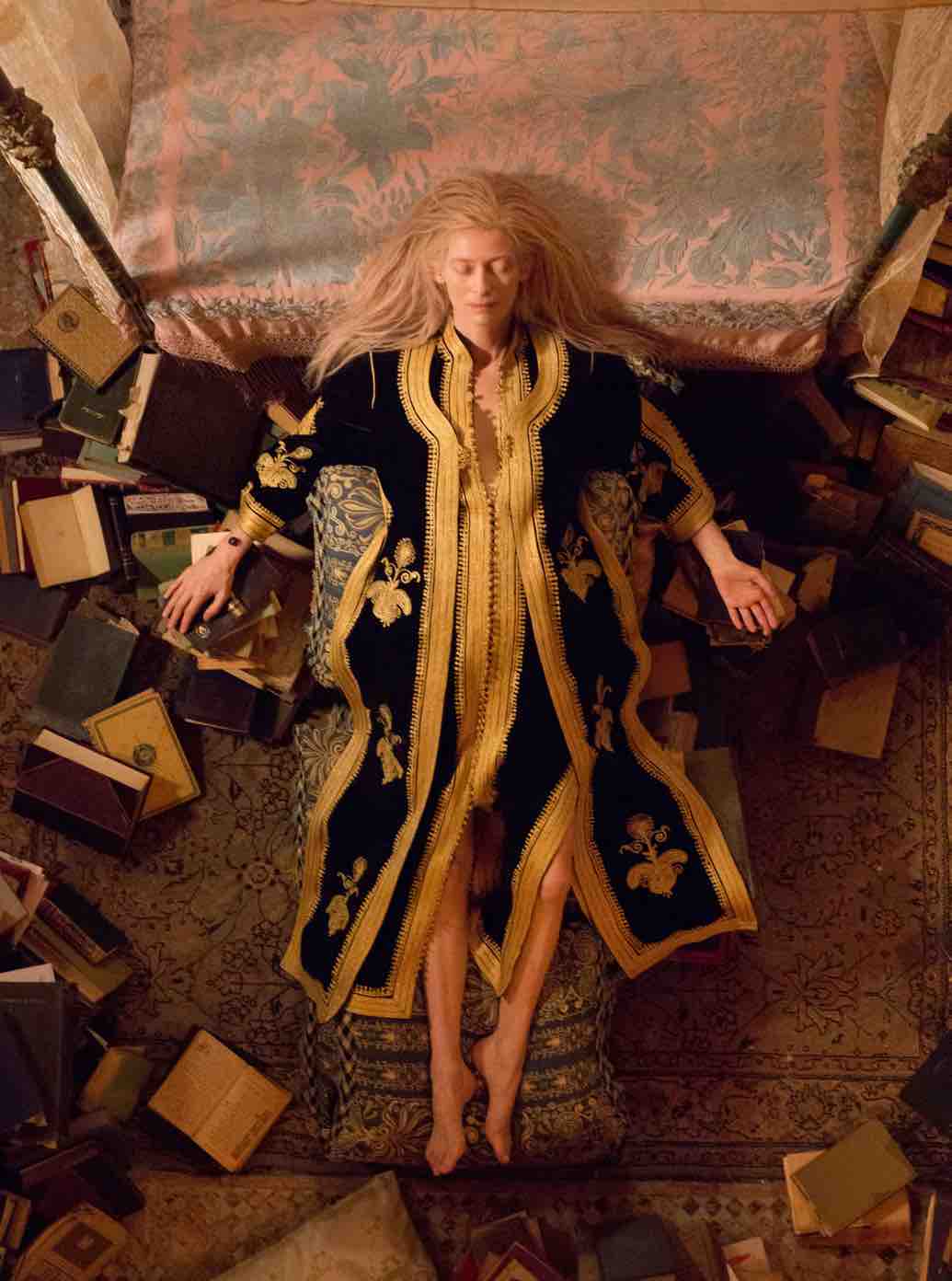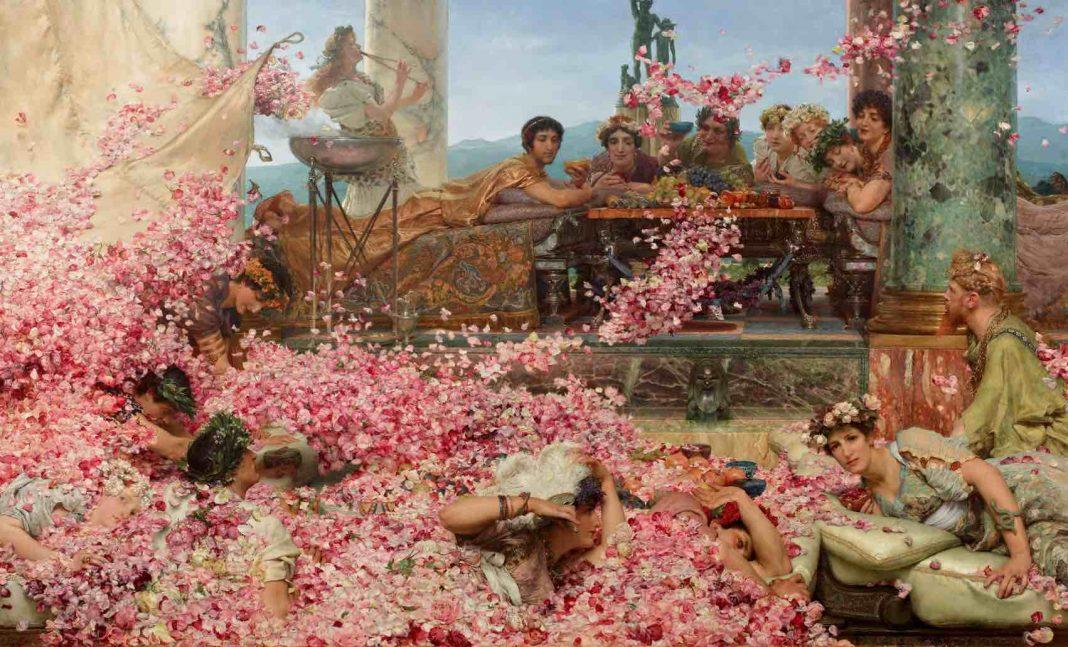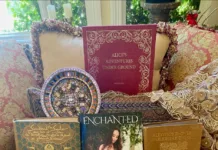Feature Image: The Roses of Heliogabalus (1888), by Lawrence Alma-Tadema
Last spring, the Brooklyn Institute for Social Research offered an online course entitled “On Decadence: Aesthetics, Culture, and Decline” that quickly—and sadly, for our Enchanted Living editors—sold out. How could it not with a description that began “From stories of Roman emperors drowning their dinner guests in roses to the reveries of Baudelaire’s Flowers of Evil, tropes of decadence—decay, decline, decomposition—have flourished in modern times.” So we sat down and asked instructor and decadence expert Rebecca Ariel Porte all about it.
Enchanted Living: How would you define decadence, in short?
Rebecca Ariel Porte: Decadence in brief! A true decadent speaks at length or remains silent. But decadence also has a funny relationship to “truth” (and I am no true decadent!), so I am happy to strive for brevity. I will fail. But also I am happy to be a happy failure.
Decadence is a concept with many faces. The simplest, broadest definition might be something like “decadence involves a narrative of decline.” The English word borrows from Latin decadere, meaning to fall away or decay from a state of health or vitality. “Decadent” can be leveled as a charge against people or practices that seem to deviate from a “healthy” norm or ideal, whether it’s in the realm of art, aesthetics, politics, economics, social forms, morality, or desires of the body. So it’s always important to ask who is crying “decadent” and whom they are speaking about. Those who have been called decadent are a disparate lot: artists and intellectuals, people of color, Jews, queers, gender outlaws, sex workers, those who are ill or disabled, communists, capitalists, working-class people who cannot or simply refuse to work, aristocrats and emperors, people hacking out a demimonde at the fringes of a constricted bourgeois society, at the end of an empire or some other form of life that seems to be guttering out like an aging candle. And many so-called decadents have reclaimed the word for themselves as an act of defiance or subversion, not always successful.
When we use decadence in ordinary conversation, we often mean something that seems excessive and magnetic at the same time, and at least slightly transgressive—a slice of Death by Chocolate, a sexual practice, an act of immorality or amorality, a fabric with a hand so luxurious it barely seems real, an opulent dwelling (and its price tag), a painting chased in gold, intoxicants, parties that last from dusk to dawn. In the contemporary vernacular, decadence often expresses a wish for a maximalist antidote to resource scarcity, economic austerity, and prevailing minimalist styles ranging from design without ornament to normcore fashion to stripped-down poetry and prose.
But even this regular, casual talk of decadence is often ambiguous. Decadence may be a protest against privation or it may be used to create desires for things you don’t need and sell you on a style of life that always promises more than it delivers. When you call something or someone (including yourself) decadent, you might be lodging a protest against an intolerable state of affairs—but you might also, deliberately or not, be dredging up all the fraught, moralizing, sometimes brutalizing history of decadence in its wake. As with so many of our great, flawed concepts, it can be hard to do one without doing the other. Sometimes decadence is neither accusation nor reclamation but diagnosis without prognosis.
One of my favorite images of the ambivalence of decadence is painter Lawrence Alma-Tadema’s The Roses of Heliogabalus (1888), which pictures one of our oldest and most persistent scenes of decadence, drawn from a history of the late Roman empire (often considered a particularly decadent period). It depicts the mad emperor Elagabalus, supine, caressed by golden silk, as he drops tons of scented petals on his guests. The history says “violets and other flowers.” The artist painted roses. A few of the revelers appear to be enjoying the extravagant festival. Others are swimming fatalities, carving through the sea of petals in which they are about to drown. I change my mind about whether I think this painting is a good painting. I am almost certain this death is not a good death.
EL: Why did you decide to teach a class on decadence at the Brooklyn Institute?
RAP: Decadence made it into the curriculum in part because I had become increasingly fascinated by the stories contemporary culture tells about decadence and partly because of student demand. Our current visions of decadence owe a lot to modernism’s ideas about decay, decline, and beauty rotting from the inside. In trying to grapple with rapid social, political, and technical changes, the 19th and early 20th centuries looked back in turn to Romantic poetry and philosophy—and 18th century history, which looked back, in its turn to remainders of Greece and Rome. When history seems composed of crisis after crisis and uncertainty about what comes next (as history often does), attempts to describe what’s happening often borrow the old Classical trope of descent from an age of gold to an age of iron—an age of decadence—which might or might not spark a struggle toward a new golden age, depending on your attitude toward providence and events in the Ancient Mediterranean. For example, Edward Gibbon’s The History of the Decline and Fall of the Roman Empire wears its charge of decadence on its sleeve, which is to say in its title.
To understand why our current narratives of decadence are so prevalent (and whom they serve), I thought it would be good to get back to basics and talk them through with a group of dazzling and witty students. (They delivered.) Basics took the form of art, theory, music, material culture, and a range of literature: the poetry of Charles Baudelaire (and Walter Benjamin’s massive, decadent scholarly romance, which turns on Baudelaire’s work), writing by J.K. Huysmans, Friedrich Nietzsche, Oscar Wilde, Marcel Proust, Henry James, Vernon Lee, Rosa Luxemburg, Vladimir Lenin, and Djuna Barnes. It was also a chance to redraw the boundaries of the category
of decadence to include figures like Jeanne Duval (a Haitian-born Creole dancer and Baudelaire’s muse and mistress for much of her life; see Robin Mitchell’s Vénus Noire) and the Biblical Salome (see Jonathan Freedman’s Jewish Decadence). An object of fascination for Moreau and Klimt in art and Wilde in theater, Salome was closely associated with Jewishness and perversion; she was played by Jewish actresses on stage and film, including Sarah Bernhardt, Theda Bara, and Alla Nazimova. The syllabus also asks if we should think about some of the writers of the Harlem Renaissance as decadents: Richard Bruce Nugent, whose “Smoke, Lilies and Jade” is an unabashed exploration of queer desire, and Nella Larsen, whose lyrical novels embrace a decadent sensuousness and also criticize its potential for racist exoticism.
Because I’m not all critical high-mindedness, I admit I wanted to dwell in decadence as a style, in its weirdness and ostentation, which are not always pleasant places to be, in its drunkenness, in perfumes so ripe they have a whiff of the grave about them, in the lushest poetry, the most grotesque prose, in colors so dark and vivid they ask the eye for a form of second sight, in forms chipped at the corners, in heady wines and soiled brocades, in strawberries soaked in ether, in squalid urban interiors and city streets, in a second nature more natural than a first nature, in acts against nature, in acts of creation that have nothing to do with biological reproduction, in loves that dare not speak their names, in smoky films that dig their fingers into the crevices of glass arcades lit by the newfangled arc lamps (which some call Yablochkov candles) and shadows more substantial than the things that cast them, the alleys of life where it is amoral to meet another’s gaze and immoral to laugh and never win and vaguely extra-moral to love without hope.
EL: What did your students say they got out of it? What did they learn?
RAP: One of the loveliest responses to the class (shared with her permission) came from a student who had expected to leave the course either “pro-” or “anti-” decadence. Instead, she said what she had come to was that, for her, decadence was more like a stethoscope you could hold over someone’s heart so you could listen for the strangeness of its rhythms—and how that fitful gallop was nonetheless keeping body and soul together. It was a lens to look through to understand something that beats at the heart of the world we know. She also said she was shocked to find she adored Baudelaire!
EL: What makes decadence relevant today?
RAP: The story of decadence right now is also the story of how decadence is endlessly modern. Certain moments in history seem to call out to one another across the years. Like the moderns at the turn of the 20th century, give or take a few decades in the past or future, we are grappling with ongoing crises of wealth divergence, social inequity, political stagnation, technological acceleration, environmental degradation, mass illness, mass fatalities, and scarcity in many arenas of life. And like Belle Époque Europe and Rome before it was sacked by the Visigoths, American empire, wrong from the start, is aging badly, violently, king of a rainy country, to steal a phrase from Baudelaire. It’s not a perfect analogy, of course. But in such a life, it makes sense to me that we would reach—to our credit, to our despair—for our own versions of decadence, like and unlike older ones, to explain our own sense of broken things that will not easily be mended, if at all, and to invent new forms of life among the ruins. Even there—even here—I suspect we will still be as fierce in our joys as in our sorrows. There’s this Hal Hartley film from the late 1990s, Henry Fool. It’s got a gorgeous, harrowing, practically Shakespearean line, which rings out athwart some of the more workaday dialogue. It is delivered by a failed novelist: “We know we have fallen, for we know who we are.” I’ve always thought that this is a good description of the best-case-scenario motive for decadence.
Many uses of decadence are about kicking people when they’re down. Others are about making the most you can of badly damaged materials. As an aesthetic, as an attitude toward the world, the second kind of decadence can often seem strangely hopeful: a defiant embrace of the underbelly, the underclass, the underworld. Decadence is yellow, yellow, yellow, the yellow of The Yellow Review and the gold, gold, gold of Klimt’s golden phase. It’s Wilde’s hothouse flowers and Proust’s epic similes, the queer lavishness of Jean Genet’s perfervid autofiction or the trans doctor in Djuna Barnes’s Nightwood, whose soliloquies drip honey and acid. It’s the languor of Walter Benjamin on hashish. It’s the feathered, saturated, sequined whirlwind, glued together with blood and sweat, of a Derek Jarman film, or the wolf-wild hair of the undead in Jim Jarmusch’s Only Lovers Left Alive, floating over a lute or a quill or lifted on the wind as the vampires indulge in a bit of ruin pornography in the abandoned monuments of Detroit. It’s the electropop camp through which the musician speeds like a Roman candle in a Lil Nas X music video. It’s Shola Von Reinhold’s Lote, which invents an early 20th century Black Scottish queer woman decadent precisely because she should have existed.
EL: To you, what is most important or alluring about decadence?
RAP: An interesting and difficult question! I think my answer for the present might be that decadence refuses to die. And like so many talented undead things, it mesmerizes the living. Why won’t decadence, always rotting, decaying, eroding, die? What is it to us that we should want to live or die through its pleasures and pains, save or kill through its force? Why do we keep resurrecting it, transforming it?
EL: How would you suggest someone begin to explore decadence (outside of reading this issue)?
RAP: This issue will be an excellent start! To the many writers and artists I’ve named above, I’ll add Jane Desmarais, a scholar of decadence who writes beautifully and accessibly. Try Monsters Under Glass: A Cultural History of Hothouse Flowers From 1850 to the Present. And the volume she edited with Alice Condé, Decadence and the Senses, is a fine introduction to decadent style and experiments in sensation. (Readers should be wary of trying some of these experiments at home!). Keep an eye out too for the work of a rising scholar, Cherrie Kwok, who is thinking ambitiously and expansively about decadence and race, gender, and anti-imperialism.
If fashion and visual media are more your style, consult digital or material archives (the Met and the museum at FIT have digitized portions of their collections) or haunt vintage clothing stores, bazaars, or conventions (my very favorite is the Manhattan Vintage Clothing Show, which is a total swoon). So far as clothing and interior design go, elements of decadent style can be found in many places, from mid-19th century Parisian gowns and hand-painted wallpaper to the Black dandies of Harlem (see Monica L. Miller’s Slaves to Fashion) to Luisa Casati’s (literally and figuratively) electric costumes in the 1920s. (One, a suit of armor pierced by arrows, shocked her so hard she flipped, and then there were the live snakes and the peacock feathers.) Silent film—the Theda Bara Salomé and Pabst’s Pandora’s Box, starring Louise Brooks, Lang’s Metropolis—all these works get at decadence’s desolation and jouissance, which can’t be disentangled. As for decadent music, the label often gets applied to any music that sounds new or alien to the audience or threatening in some way (morally, erotically, politically): jazz and the blues, for instance, were often condemned as decadent by white critics for their uniquely Black, American invention as well as their radical, improvisatory sounds. Try some Bessie Smith or Fats Waller? But late Richard Strauss and the atonal music of Schoenberg have also been called decadent, as has Brecht and Weill’s marvelous Threepenny Opera. And I can’t resist recommending some contemporary decadent musicians: Lacy Rose and her Starling Quartet.
EL: Were women a significant part of decadence—and, if so, in what ways?
RAP: Yes! Although scholarship is still catching up in many ways. Decadent women were writers (Vernon Lee, Rachilde, Renée Vivien, Colette), dancers, performers, polymath models-lovers-muses-managers-mothers-maids-of-all-work (Jeanne Duval to Baudelaire, Wally Neuzil to Egon Schiele, Emile Louise Flöge to Klimt) and much more besides. Those who didn’t paint or write themselves were often involved in promoting or publishing decadent work—or else making it possible for artists to paint and writers to write by taking care of all the daily business of social reproduction—care work, paying bills, begging for money to pay bills, cooking, cleaning, and all the rest. The canonical decadent position rests on an enormous, invisible foundation of unwaged labor and material privileges. Decadent women were also courtesans and salonnières. And many were deeply involved in theater—the Salome actresses mentioned above, for instance. In a way, the difficult art for many of these women was world making in decadent conditions and against steep odds. Some challenges are still with us, even if they’re played in a different key, even if we, the players, are different too.

EL: How might one of our readers incorporate the spirit of decadence into their everyday life? How do you, if you do?
RAP: If you choose to call yourself a decadent, you might try your hand at nurturing your own louche and luxurious demimonde—though a decadent never works too hard—nevertheless, insist on exploring the full range of your capacities; revel in the messy, horrible wonders of the body and of human connection, human alienation; refuse to despair and refuse to refuse to despair; demand opulence; be generous; be prodigal; be irresistible; be immovable in the face of pallid convention; burn the day for the night. Do something delicious and indulgent for yourself without trying to justify the pleasure in any way, including self-care, wellness, or sanctimony. Have I missed anything? Oh—be suspicious of anyone who calls you decadent—and call no one good, including yourself. As for me, well, I am that tiresome thing, a critic. This means I always have one foot out the door and I sleep with my eyes open where decadence is concerned, where most things are concerned. These are not endearing qualities. Like all things, like people, decadence is made of its contradictions. I can’t see what decadence can do for us without seeing what it can do to us. I mean, the spirit of decadence is with me whether I like it or not. It is not always a happy haunting. But the ghost tells very good jokes on occasion.
Have I a decadent lifestyle to reveal? Apart from being haunted? Apart from feeling myself most awake at dawn and twilight, the most equivocal passages of the day? Well, I can’t let you pluck out the whole heart of my mystery! But as an unrepentant lazy hedonist, I suppose I share the decadent’s penchant for aesthetic pleasures, sensuous pleasures—though mine are more secret and profound than spectacular—and the decadent’s need for ornament in dress, design, and architecture, in poetry and music. They loved yellow. And they loved gold—partly for its terrible, magniloquent history, partly because it glitters and that is a form of beauty, partly because it is a bloody substance, partly because it is a yellow metal and rare. My experience of gold has been largely unhappy, and I generally avoid the real thing (or it avoids me). I have no desire to possess it. Still, I love its glimmer in the eye, which is a sweetness close to pain: in a picture frame or a gold-ground painting or an image in a poem. It quivers, that glimmer, as if it were alive and flirtatious, alive and poised to bolt. I have to ration meetings between my eyes and that gleaming, which is like a visitor fallen from some distant planet whose name we don’t know.




































